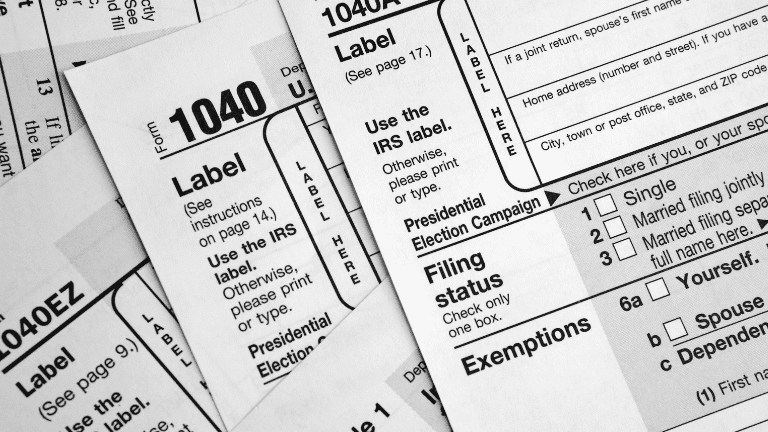President Joe Biden hasn’t hidden his desire to raise taxes on corporations and the wealthy. It is his way to fund a multi-trillion infrastructure package and new social programs. Details are likely to change as the legislation makes its way through Congress, yet many are already wondering how to prepare for Biden’s new tax laws.
While history reveals that the stock market does well during periods of higher taxes (as higher taxes often come with stronger economic growth), it doesn’t mean you should sit idly by and not do anything with your money amidst increased taxation. In fact, higher taxes will require an investor to be more adaptive and diligent.
Here are some ways you can prepare for Biden’s new tax laws:
—– (or scroll to the bottom for the recap video) —–
Long-Term Capital Gains and Qualified Dividends
Proposed change:
The proposed Biden tax plan includes nearly doubling the long-term capital gains (gains on assets held for over a year) for those making more than $1 million. This is up from a 20% maximum rate (plus 3.8% net investment income tax) to 39.6% (plus 3.8% net investment income tax). This results in a top marginal rate of 43.4 percent.
How to prepare:
We are firm believers that long-term goals, not taxes, should be the primary driver of decisions. However, preparing for Biden’s new tax laws surrounding capital gains could compel some high-income investors to consider selling off assets before the tax hike takes effect. Others will look into alternative strategies to lower their taxes.
Gauging the impact of capital gains requires careful analysis. It is important to look at projections of future income and tax brackets. Capital gains taxes, unlike income taxes, are discretionary. This means that investors have greater flexibility on when to sell their investments. As such can determine how much tax they will have to pay in a specific tax year. For example, there may be years in the future when someone’s income falls below the proposed $1 million threshold, resulting in a lower rate.
As a rule of thumb, realize capital gains when necessary to fund goals and manage risk. Consider realizing capital gains at today’s low rates (pre-Biden’s changes) if needed to fund shorter-term goals. For longer-term goals, investors may choose to retain the investments in the event future tax reform lowers the capital gains tax rate.
Also, consider utilizing an asset location strategy by placing inefficient tax assets in tax-deferred or nontaxable accounts. Interest income, dividend income, and realized capital gains do not get taxed in IRAs. We also recommend considering installment sales to regulate annual income levels, keeping income under $1 million as much as possible.
Basis Step-Up at Death
“In this world nothing can be said to be certain, except death and taxes.” -Benjamin Franklin
Proposed change:
Biden’s new tax plan is proposing to end the longstanding tax exemption for investment appreciation when a taxpayer dies. This tax break is the step-up in basis. Changing it could raise taxes at death significantly for top-earning Americans.
Currently, if you inherit an asset that increased in value when the person who died owned it, the asset’s basis is increased to the property’s fair market value at the date of the previous owner’s death. This adjustment is called a “step-up” basis. The increase in basis also means that the person who inherits the property can sell it immediately without paying any capital gains tax because there is technically no gain at that point to tax.
The current step-up saves taxpayers more than $40 billion a year, according to the congressional Joint Committee on Taxation. The new proposal would take back some of that to help pay for social programs. It would be a profound change to a provision that has been in the tax code for 100 years.
Under the proposal, the un-taxed gains on investments held at death, such as stocks, land, or a home, would likely be taxed at a top rate of 39.6%, above an exemption of $1 million per individual, plus $250,000 more for a primary home. For married couples, the total exemption would be doubled, to up to $2.5 million of gains.
How to prepare:
Potential strategies that could help with this rule change include the use of flexible grantor trusts, which allow swapping assets, borrowing, loaning; Irrevocable trusts which permit gifting to charity to avoid a deemed sale and capital gains); consider prioritizing low-basis assets for charitable giving. If this proposal goes into effect, we suggest discussing options with your advisor and tax professionals.
Estate and Gift Tax Changes
Proposed change:
Under Biden’s new tax laws he is proposing to reduce the estate and gift tax exemption amount to $3.5 million. Maybe lower. The current exemption amount is $11.7 million. A reduction in this amount will result in more tax for many families at death. For example, an estate of $5 million (currently under the $11.7 million limit) would be taxable for amounts over $3.5 million.
How to prepare:
Consider using and funding a GRAT (grantor retained annuity trust) to transfer excess growth of appreciating assets while minimizing gift and estate taxes. Today’s GRAT rates are historically low, so this is an ideal time to create a GRAT. Consider funding trusts now. Particularly those that are expected to need cash to meet future expenses, such as life insurance premiums, in case annual exclusions are capped. We recommend discussing such strategies with your lawyer and/or CPA.
Further, you can still implement annual gifting. Current limits allow for gifts up to $15,000 per donee per year. A solid strategy used to pass wealth while staying within IRS limits. A married donee may gift $15,000 to a spouse, as well.
Individual Income Tax
Proposed change:
Biden is also proposing to increase the top individual ordinary income tax rate to 39.6% for families making more than $400,000 ($200,000 for individuals). The current tax law is 37% top individual ordinary income tax rate. The proposed income tax increase is relatively small. It would return it to 2013-2017 levels, however, there are still some tax mitigation opportunities.
How to prepare:
First, make sure you are fully funding your 401k and IRAs, further convert traditional IRAs into a Roth IRA, i.e. a Backdoor Roth. Revisit elections on deferred compensation plans.
Other Proposed Tax Laws
Biden’s proposed new tax laws include much more than listed here. These are the biggest changes, to read more about all the proposed changes reference The American Jobs Plan and The American Family Plan.
Although definitive tax policy changes have not yet been enacted, it is highly likely we will see changes to the tax landscape late in 2021 or early 2022. Biden’s new tax laws could have a significant impact on your finances and taxes, with specific changes on investment income. Bonfire Financial can help you create a financial plan and optimize your tax strategy based on your needs and goals.
If you have questions on how to prepare for Biden’s new tax laws or are interested in scheduling a financial planning audit, please reach out to our CFP® professionals at 719-394-3900.
—– (watch the recap video) —–
 Client Login
Client Login









